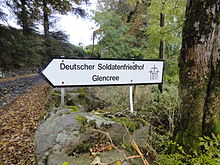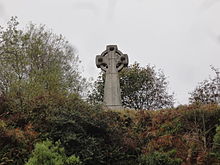Glencree German War Cemetery
When German military cemetery ( english German Military Cemetery ) in the south around 16 km from Dublin located Glencree ( Irish Gleann CRI ) in County Wicklow is the only of its kind in Ireland . It is located in the immediate vicinity of the Glencree Center for Peace and Reconciliation , a facility in which 50 German orphans were saved from possible starvation as part of Operation Shamrock after the end of World War II .
Location and description
The cemetery is laid out in a disused quarry and was expanded by the Volksbund Deutsche Kriegsgräberfürsorge in the years 1959–1961. The Irish government made the site available free of charge for this purpose. A street sign in German indicates the facility. A natural stone wall separates it from the street. Behind a wrought-iron gate, a path leads to the mourning hall and the burial ground. 134 dead are buried on the cemetery planted with cranesbills , 6 of them from the First and 128 from the Second World War . In pairs, the dead share a nameplate arranged in the floor, provided that identification was possible.
A triangular granite stele arranged at the entrance to the burial ground bears the following memorial by Stan O'Brien in English , Irish and German :
“My lot was death under Irish skies and a bed in Ireland's good soil. What I dreamed and planned tied me to the fatherland; but the war sent me to sleep in Glencree. Suffering and pain was what I lost - and won. When you pass by, say a prayer that loss will turn into blessing. "
The mourning hall, clad with natural stone, is decorated on the ceiling and interior walls with mosaics based on a design by the Munich painter Beck. On the side of the cemetery there is a strikingly different gravestone, the gravestone of Hermann Görtz .
The entire complex is dominated by a typical, widely visible, Celtic high cross .
Historical background
The Irish government made the area available for the cemetery free of charge for an indefinite period of time. 1959 to 1961 the facility was built by the Volksbund Deutsche Kriegsgräberfürsorge . The inauguration took place on July 9, 1961. The dead from over 100 individual graves throughout Ireland were brought together in Glencree.
Six of the dead come from the First World War . They died as prisoners of war in British camps. The majority of those killed in the Second World War are members of the Luftwaffe who crashed in neutral Ireland as a result of overflights over Great Britain , as well as seafarers stranded on the coast. Among these dead are 46 victims of the Arandora Star , which was sunk by the German submarine U 47 in July 1940 and had on board German and Italian civilians interned by Great Britain, among others.
A grave slab refers to an unknown Belgian war dead. This corpse was washed up on January 17, 1941 near Bartragh Island ( Killala Bay ) and is believed to have come from the Ville de Grande .
In total, only 59 of the dead are identified as no papers, identification tags or other identifying features were found on the bodies washed ashore.
The gravestone of Hermann Görtz, to which an inscription on one of the plates is dedicated, is a specialty. He worked during the war in a German mission as a spy in Northern Ireland, killed in 1947 itself and was in 1974 by Deans Grange Cemetery reburied here.
Since the memorial was set up, memorial events have always been held on the day of national mourning. As a sign of reconciliation, the Royal British Legion also has floral wreaths laid.
literature
- Glencree Center for Reconciliation The Glencree Story
Web links
- War cemeteries managed by the Volksbund Deutsche Kriegsgräberfürsorge
- Information from the online project Fallen Memorials
Coordinates: 53 ° 12 ′ 3.3 " N , 6 ° 17 ′ 32.4" W.





